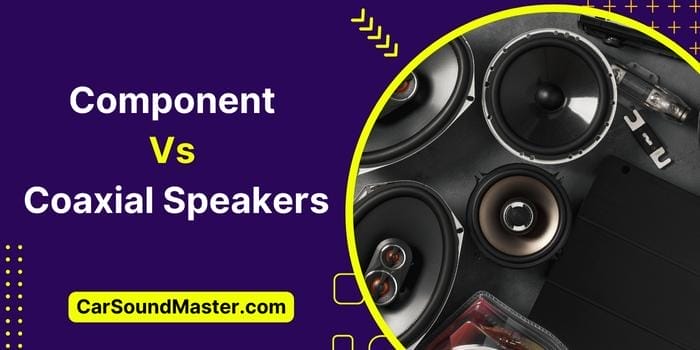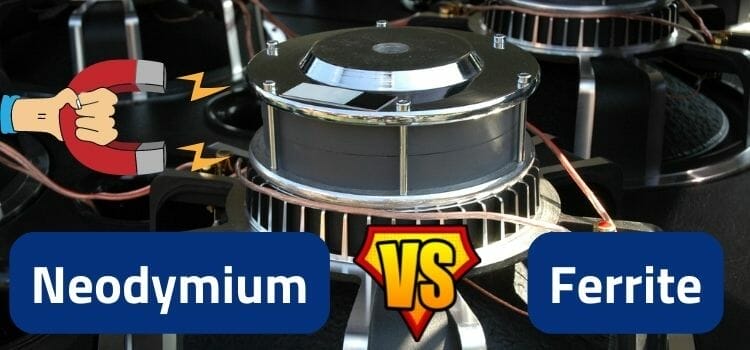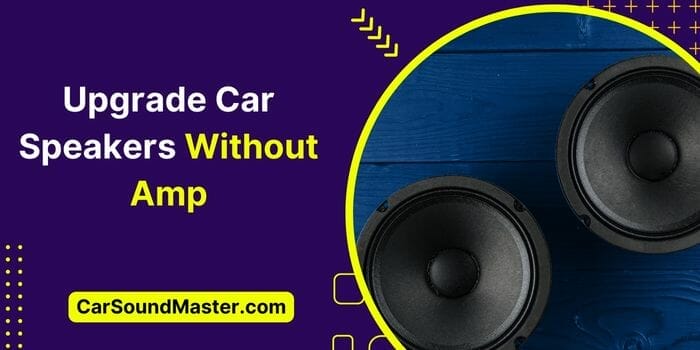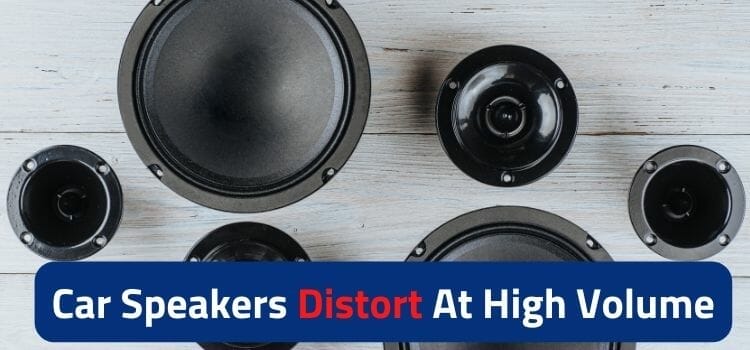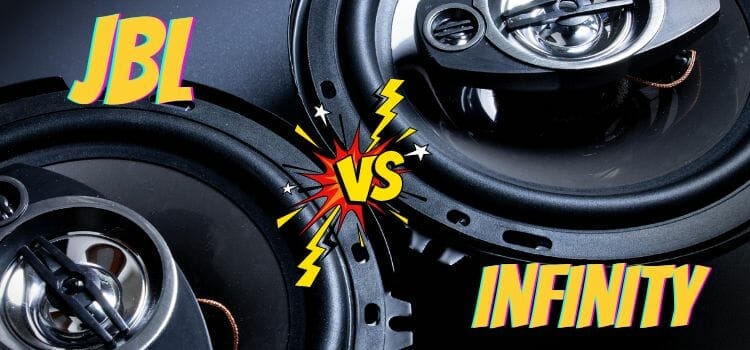I Tested Component Vs Coaxial Speakers | Here’s What I Found
Seemingly, it’s just two categories of speakers to choose from i.e. either one or the second – as simple as that. But when it’s finally the time to get them, you have tons of factors to consider to make a well-informed decision about the speaker type that’s gonna be tailor-made for your type of needs
That’s one, and the biggest, reason why despite being quite fuss-less, “component vs coaxial speakers” is one of the hottest topics in the town.
Well, at first look, the component speakers are absolutely the winners of the contest as they offer so much more than the coaxial speakers.
For example, components have superior sound quality, vast and precise frequency response, high power ratings, customizable drivers, separate crossover, and flexible placement options, etc.
But there are also areas where coaxials do it altogether better than components i.e. less costly, easy to install, space storage, low power requirements, etc.
So to fully understand which one is the ideal speaker type for you to bet on, read along – with patience.
Component Vs Coaxial Speakers
Coaxial and component are the two most rampant speaker types with the former relatively bossing the popularity charts (for its ease of use esp.), whereas the latter bossing the mind and heart of enthusiast audiophiles.
Let’s now set them against each other in whatever ways possible.

Speaker Composition, Types, and More – How Do They Both Work?
Here is what I found.
Coaxial Speakers – Single Assembly with No (Or Very Little) Customizations
Introduced in the early 1970s, coaxial is the most common type of speaker universally available.
A coaxial speaker incorporates all the different drivers (woofer, tweeters, subs) and crossovers into a single assembly which is why they’ve also got the name – “full-range speakers”. The name “full-range” signifies all the frequency spectrums produced from a solo unit.
Coaxial speakers can be of different types based on the number of drivers incorporated. A 2-way coaxial would simply mean a woofer (also called bass speaker) with a tweeter mounted on top of it connected via a simple (maybe a capacitor in series) crossover.
For a 3-way speaker, it’s a combination of 1x woofer, 1x tweeter, and 1x midrange driver as well with, of course, a crossover. Whereas, in 4-way (quad-axial) speakers, the midrange drivers (or in some cases tweeters too) go 2x in addition to all the previous settings.
As coaxial speakers contain all the same drivers combined into one to save on space and money, think of them as a centrality between older solo-cone speakers and premium components.
Coaxial speakers produce all the audible frequency ranges (i.e. 20Hz to 20KHz for a human ear) from a single axis/point in space resulting in poor sound staging.
Nevertheless, as coaxial speakers are always good middle-ground speakers saving cost and space, they’re heavily popular, esp. in car stereo setups.
Component Speakers – Tweakable Mountings and Tons of Flexibilities
Component speakers, as their name suggests, are speakers with drivers and crossovers not built into one assembly but each gimmick working as an independent component. All these components then work in harmony to produce perfectly staged optimal sounds.
There are also multiple types of component speakers available in the market i.e. 2-way, 3-way, 4-way components, etc. Their composition is the same as that of coaxial of these types except for the crossovers as, obviously though, in component speakers, you’ve more of them – separate for each driver.
Now because components give you freedom in mounting customizations, you’re flexible in placing tweeters (also midrange drivers – in 3-way components) and crossovers however you deem them perfect.
Additionally, unlike in coaxial where the single crossover is assigned the job, the separate crossovers in components mean dedicated filters for each driver. This translates into each driver receiving only the frequency spectrums it’s designed to play.
For that reason, component speakers produce more definite, well-surrounded, stable, and natural sounds.
#1. Sound Quality and Frequency Range Response – The Better of the Two?
Let’s find out.
Component HT & Car Speakers – Always the Best
When it comes to the component vs coaxial speakers sound quality, the components are the definite winners – by a mile; having described their constructs, you should understand why.
Obviously, component systems have so many reasons to throw exceptionally precise sound notes provided their power requirements are met.
They give you freedom in mounting drivers which makes for bridging all the gaps of a coaxial setup and a more natural and clearer sound. The two stages of filtering through the separate crossovers also result in a way more effective block-and-pass to each driver.
Apart from that, the more advanced components use better domes, excellent PET or similar magnetic build plates, high-quality materials for drivers, leading-edge crossovers, etc.
That said, the individual drivers in a component system are perfectly tuned for the specified frequency ranges (i.e. woofers for bass, tweeters for highs, midrange for mid-spectrum).
Therefore, the frequency response range of component speakers is always vast and superior to that of coaxial speakers.
Coaxial Car Speakers – A Good Cost-effective Upgrade to Your OEM Stocks
These speakers, as already mentioned, just hit the sweet spot between too old/poor and too advanced. Coaxial speakers are simply the mid-tiers, you may say.
Unlike the traditional single-cone speakers where the sound quality is bad even if you add a whizzer, a coaxial speaker sounds far better if used in small spaces like vehicles, etc. But because of the single axis, music from a coaxial speaker altogether feels unidirectional and not natural.
In addition, for instance, in a 2-way coaxial there’s always a single crossover dedicated to the tweeter only (which means it just filters out bass notes from the tweeter), and the woofer is subjected to all sorts of frequency bumps.
So none of the drivers is tuned for a certain frequency range and their solo-axis placement also makes for a relatively limited sound spectrum coverage.
All in all, a coaxial speaker may produce louder sounds than a component system but the music here will always be unstable, not so accurate, and smudged as compared to that of a component.
#2. Power Handling and Ease of Use – Which of the Two Is Simpler to Install?
Let’s find out.
Coaxial Speakers – Fixed Placement but the Easiest
The biggest reason why coaxial speakers are said to be the first-choice upgrades for your vehicle’s OEM stocks is their absolutely simple wiring and installation. It’s just a drop-in.
Coaxial speakers simply need a single connection of one speaker wire coming through the car’s amp/receiver/head unit. These speakers usually fit into the same holes (provided the size of stock and aftermarket is the same) as your car’s factory-fit speakers and wire through the same connections.
So it’s that fast and stress-free. What adds more to the luxury here is that coaxial speakers come with quite low RMS and peak power ratings so you won’t need to get any powerful pusher for it too. They will work fine with almost any stereo.
Component Car Speakers – Flexible Placements but Bit of a Hustle
Coming as individual units in separate enclosures, component speakers generally make for a bit complex installation. They require more space, more wires, and an altogether different wiring schema.
While wiring, component systems are pretty much first connected to the crossovers and then the drivers i.e. tweeter and then woofer, respectively (for 2-way components). This translates into multiple connections and multiple wire schemes.
In illustration, you should start with your car’s amp/receiver’s output wire making it through to your component system’s crossover with the crossover outputs for each driver then joining the respective terminals of the respective drivers’ inputs.
Finally, because components are usually rated at rather higher RMS and peak power compared to coaxial speakers, you generally need a more powerful amp to make them run at full throttle.
For your understanding, a good component system would usually carry an RMS rating of around 60 to 100 watts. Whereas for a great coaxial set, the RMS rating would be at 65 watts – the very maximum, I believe.
#3. Pricing, Buying Options, Availability – Who’s the Winner?
Coaxial Speakers – Bossing All These Areas
To understand why coaxial speakers are bossing all these areas of comparison, let’s recap some of their specs and features. For example, they: are the first-option upgrades to your automobile stocks; require fewer watts to run at full tilt; make for a drop-in type of stress-free installation, etc.
Coaxial speakers serve the largest market proportion by being, kind of, the best mid-range little machines available. They are way better than the older single-cone speakers and not as elite as component sets.
These are available for almost every price point ranging from just acceptable sets for the tight penny-pinchers to some top-notch traceries for the easy spendthrifts. So almost anyone can manage to afford them.
Plus, most of the automobile’s OEMs are now making full use of coaxial/full-range speakers as well, courtesy of their cost & space-effectiveness and simpler installations. That also translates into a very vast array of options to choose from both for manufacturers as well as aftermarket repairmen.
All these things combined make for their universal availability – everywhere and for everyone, no matter what.
Component Sets – Pricey, Tilt More Towards Enthusiast Audiophiles Only
Component speakers come quite pricey in the stream and you should understand why. Their high prices are worth their distinct features, for example, individual units in dedicated enclosures, high-quality drivers, cutting-edge crossovers, high power ratings, etc.
With all their specs in view, component speakers are not as much preferred for vehicles except when it’s the case of a car-lover audio fanatic.
One more reason why they’re the best for home theatres and not vehicles is that they require more space and it’s often difficult to fit them in cars – esp. the small Sedans or Hatchbacks.
So for their pricing and exclusiveness, component sets are neither as popular and readily available nor offer as vast an array of options as the coaxial speakers.
Nonetheless, you can still find them for different price points with them also trying to cater to the needs of every high-end and live-like music lover.
Finally, Component or Coaxial Speakers? What’s the Best Option of the Two?
As we see all the detailed comparisons above, we can quickly conclude that component speakers can be the best bet for exclusive music fanatics, whereas coaxial can be a go-to option for budget-oriented middle-ground swains.
But let’s briefly revisit the pros and cons of both the speaker types before we can say anything further.
Pros of Coaxial Speakers
Some noteworthy advantages of coaxial speakers include:
- These are the first-choice go-to upgrades to your factory speakers – simplest to install
- Are easy both on your pocket as well as the space requirements
- Need no additional crossovers and are the easiest to set up
- Are universally popular and come with a vast array of options and price ranges
- Easily deliver full-range sounds (though not perfect); are the best speakers on a budget
- Need to additional amps; fine with any standard stereo
Cons of Coaxial Speakers
Their negatives, though:
- No such clarity and more distortion due to the tweeter making a (fixed) 90-degree conical angle to the woofer’s flux
- Comparatively not as top-notch driver and crossover materials (esp. in average coaxials)
- Limited frequency range response
- Low power ratings may be an issue
Pros of Component Speakers
The advantages of component sets are as follows:
- Stable, incredibly accurate, and more crisp surround sound with a much wider frequency response range
- Advanced crossovers and perfectly tuned high-quality drivers
- Flexible placements/mounting customizations for optimal imaging and sound staging
- High power handling capabilities
- In case of miniature collapses, component sets are easier to fix due to individual drivers and crossovers (than a single-assembly coaxial)
Cons of Component Speakers
As for the disadvantages of components, here’s what:
- Individual drivers require separate crossovers – more bucks and space required
- Pricey speakers overall; not as much popular
- Bit complex to set up and install
So that’s more or less how these two categories of speakers set and do against each other in all the areas possible to collate.
Conclusion
At the business end, I should finish this “component vs coaxial speakers” debate on a high with a few last-minute suggestions for you on when to choose what type of speaker.
Go for Coaxial Speakers If
If you are a person with a tight budget and you’re not much into hi-fi music things, you should ideally bet on coaxial speakers. They are the best upgrades to your old and traditional single-cone car speakers and for so many good reasons.
They sound enormously better than them yet easily fit into those holes and carvings and use the exact wiring schema as those factory stocks. Coaxial speakers also don’t need any added amplifications but just another simple and standard stereo.
In addition, for anyone with a car that has one speaker per door panel, the coaxials are again the way to go.
Get Component Speakers If
On the contrary, if you’re a real music fanatic with enough bucks in your pocket, component sets should be your go-to option – no matter what.
Their advanced builds, high-profile sounds, gimmick quality, power handling, safety-ensuring crossovers, customizations, controls, etc., make them the tailor-made speakers for any high-end audiophile.

